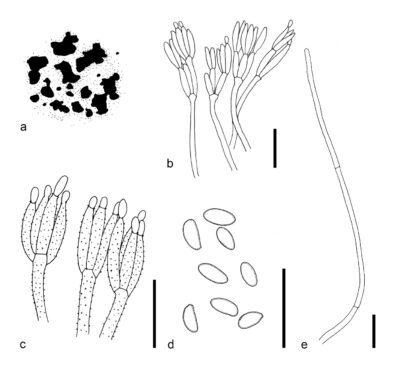Fungalpedia – Note 321, Parvothecium
Parvothecium L. Lombard & Crous
Citation when using this entry: Perera et al. 2024 (in prep) – Fungalpedia, genera described in 2016.
Index Fungorum, Facesoffungi, MycoBank, GenBank, Fig. 1
Classification: Stachybotryaceae, Hypocreales, Hypocreomycetidae, Sordariomycetes, Pezizomycotina, Ascomycota, Fungi
Lombard et al. (2016) established Parvothecium for a single species based on phylogenetic analysis of cmdA, ITS, rpb2 and tub2 loci. The second species was introduced into the genus by Gordillo and Decock (2018). Parvothecium species produce sporodochial conidiomata that are stromatic, superficial, scattered, and rarely gregarious. They are oval or irregular in shape and are surrounded by an olivaceous green to dark green slimy mass of conidia. The stromata are well-developed, hyaline with an angularis texture. The setae are sparse, septate, flexuous, hyaline, thin-walled, and tapered to obtuse apex. The conidiophores of Parvothecium have smooth to verrucose walls, and are macronemtous, penicillately branched, and hyaline. The conidiogenous cells are phialidic, hyaline, smooth to verrucose walled, cylindrical and narrower towards the tip with conspicuous collarettes and periclinal thickenings. The conidia are aseptate, ellipsoidal to asymmetrically ellipsoidal, smooth-walled, hyaline, and pigmented with age. Occasionally they have narrow truncate bases and slightly curved acute apices. The sexual morph remains undetermined (Lombard et al. 2016). Parvothecium species are associated with soil (Lombard et al. 2016; Gordillo & Decock 2018).
Type species: Parvothecium terrestre L. Lombard & Crous
Other accepted species:
- Parvothecium amazonense Decock & Gordillo
Figure 1 – Parvothecium terrestre (CBS 198.89, ex-type). a Sporodochial conidiomata. b Conidiophores and conidiogenous cells. c Conidiogenous cells. d Conidia. e Seta. Scale bars: a, b = 20 μm, c–e = 10 μm. Redrawn from Lombard et al. (2016)
References
Entry by
Rekhani Hansika Perera, Center of Excellence in Fungal Research, Mae Fah Luang University, Chiang Rai, 57100, Thailand.
(Edited by Kevin D. Hyde, Samaneh Chaharmiri-Dokhaharani, & Achala R. Rathnayaka)
Published online 27 August 2024
